Abstract
Kinematic analysis and surface electromyography were used to study reaching by five subjects with left hemiparesis as they attempted to touch each of three targets. The targets were placed to require movement within and out of extensor synergy. Each subject was tested five times over a nine week period. Over this time, amplitude of peak velocity and sense of limb position significantly improved in the paretic arms. The increase of amplitude of peak velocity was more strongly related to a decrease in the discontinuity of movement (r = -0.48) than to maximal level of contraction of the prime movers (anterior deltoid: r = 0.25; biceps: r = 0.39). This finding may be a sign of learning or increased maturity of reach. These results, if replicated in a larger sample, would support therapy designed to improve learning of new sensorimotor relationships in the hemiparetic limb.
Full text
PDF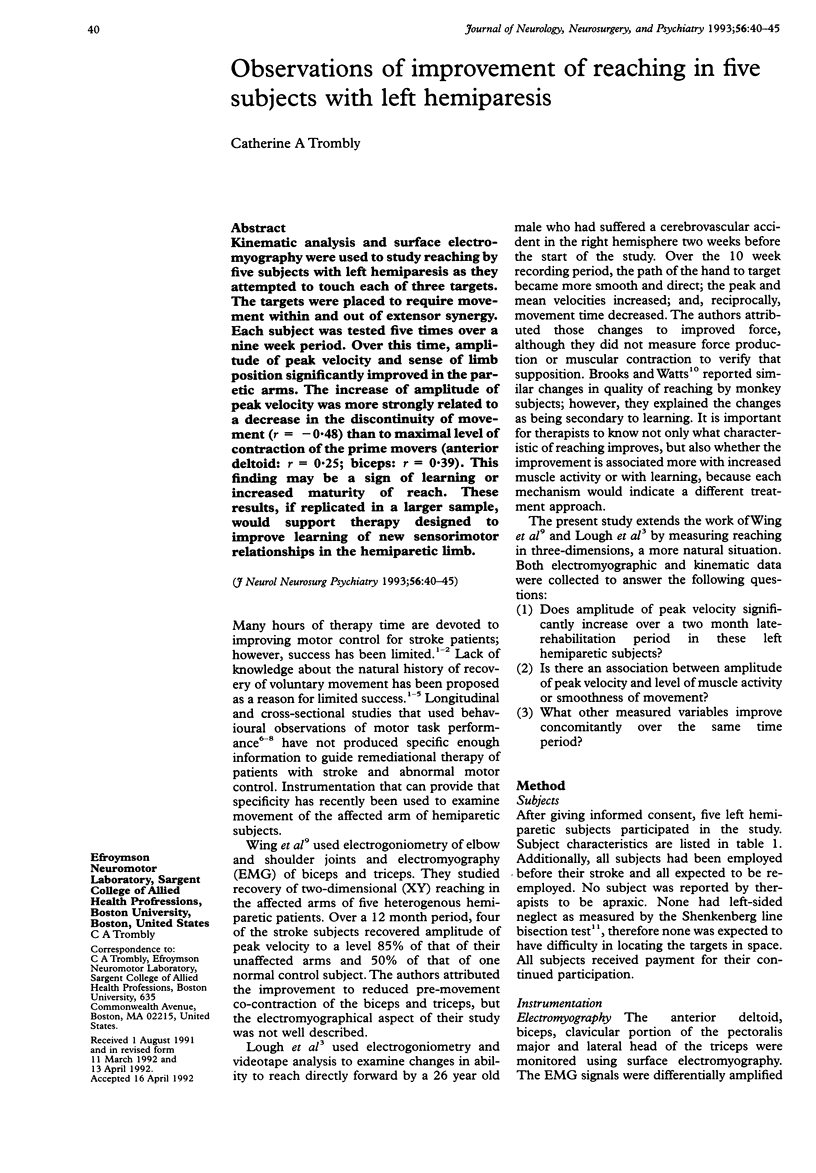

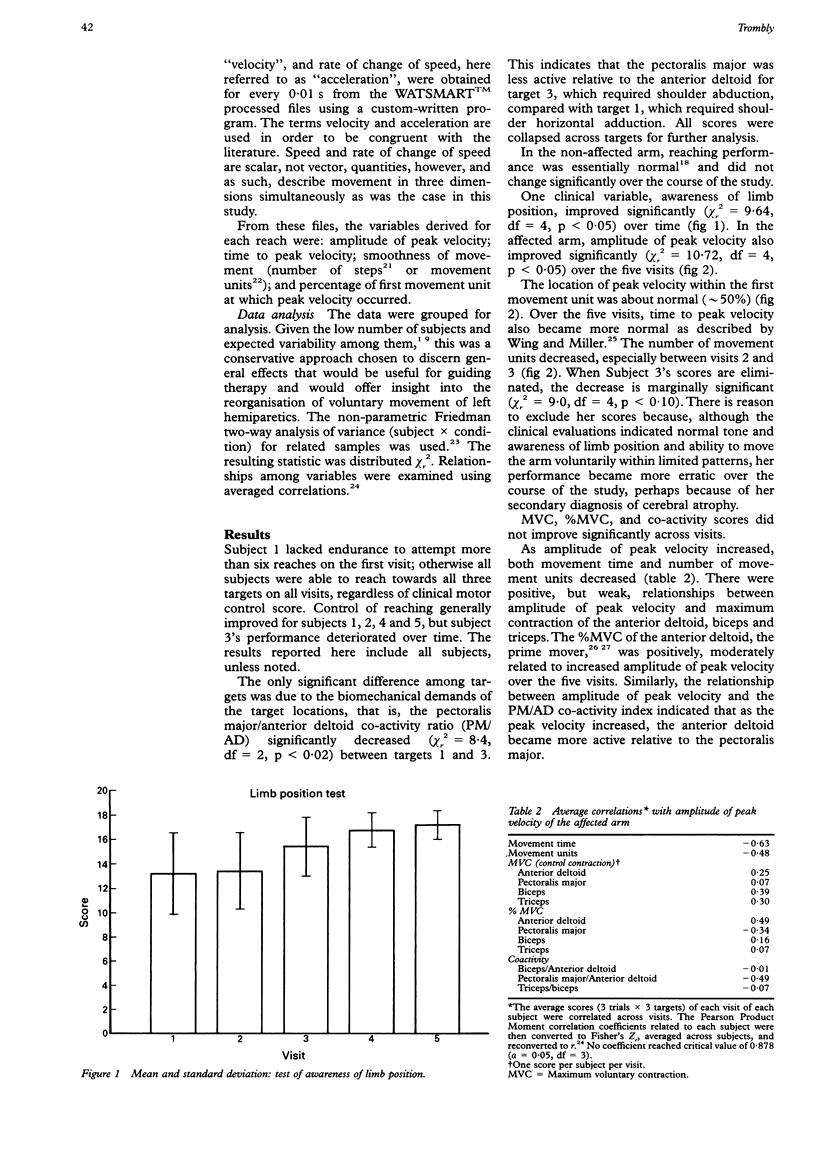
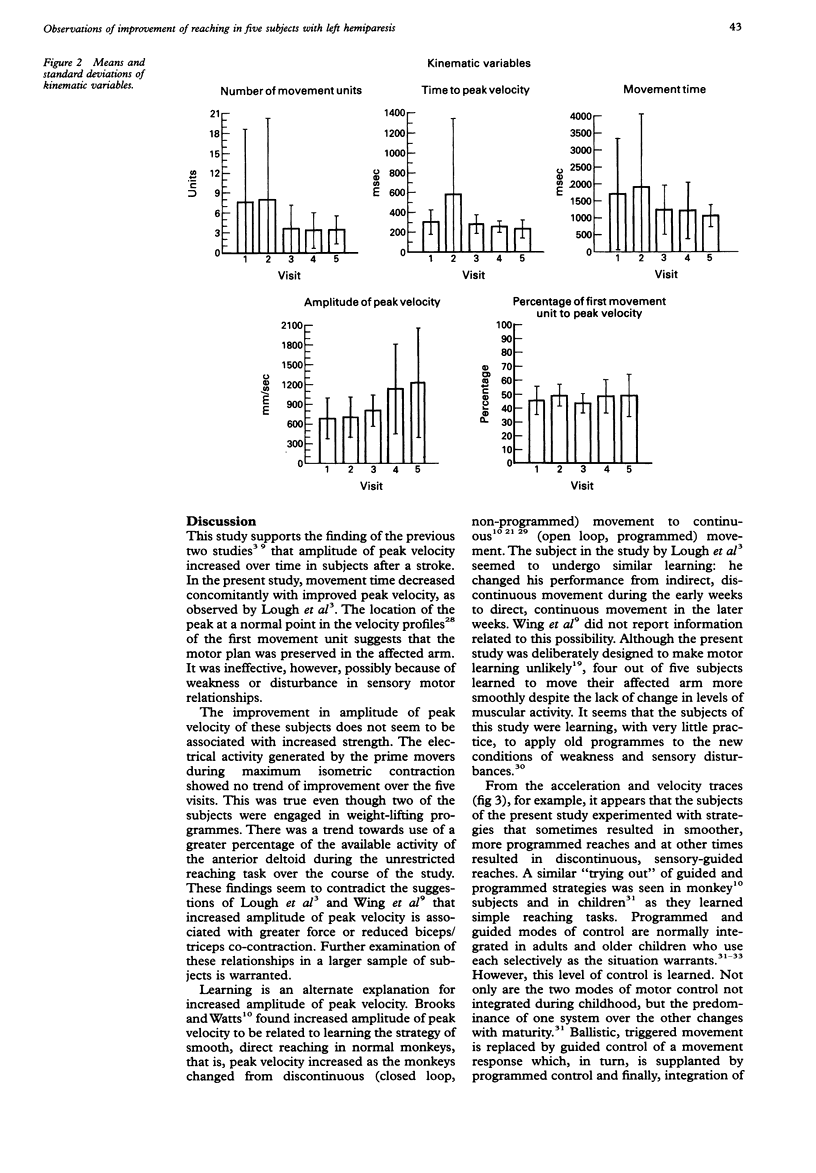
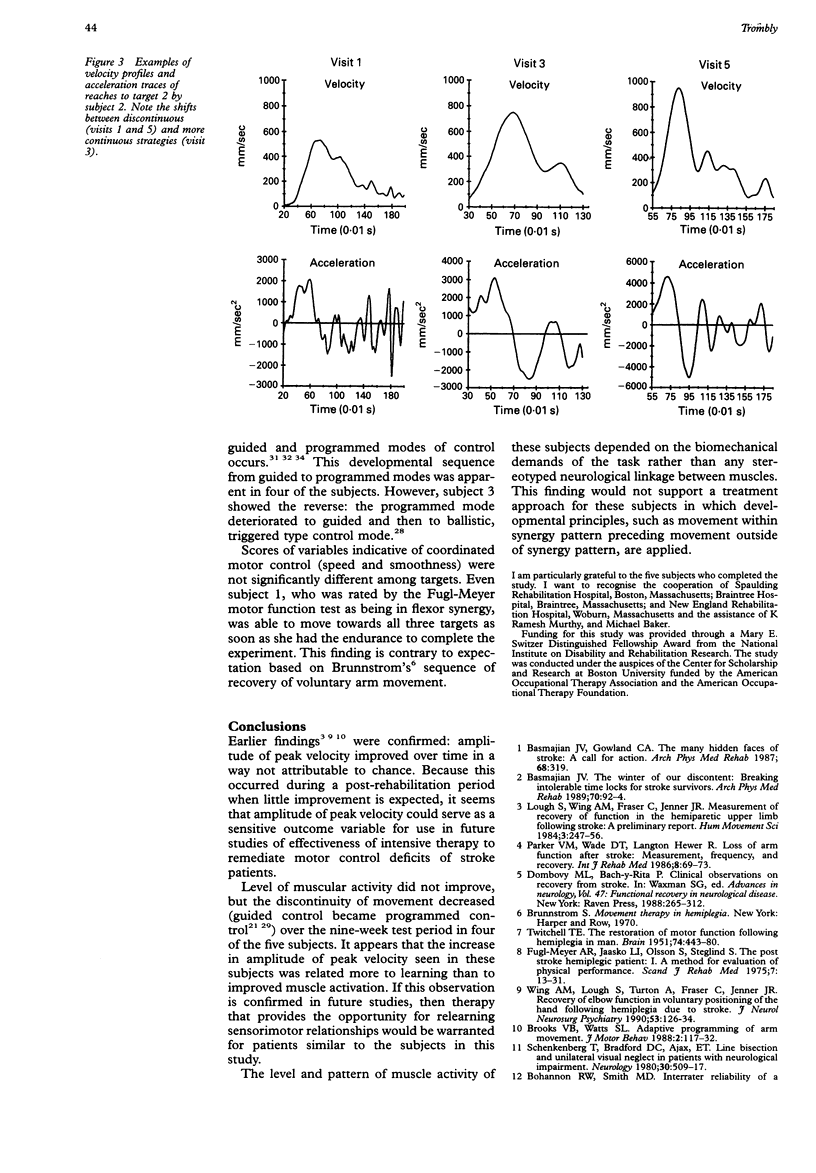
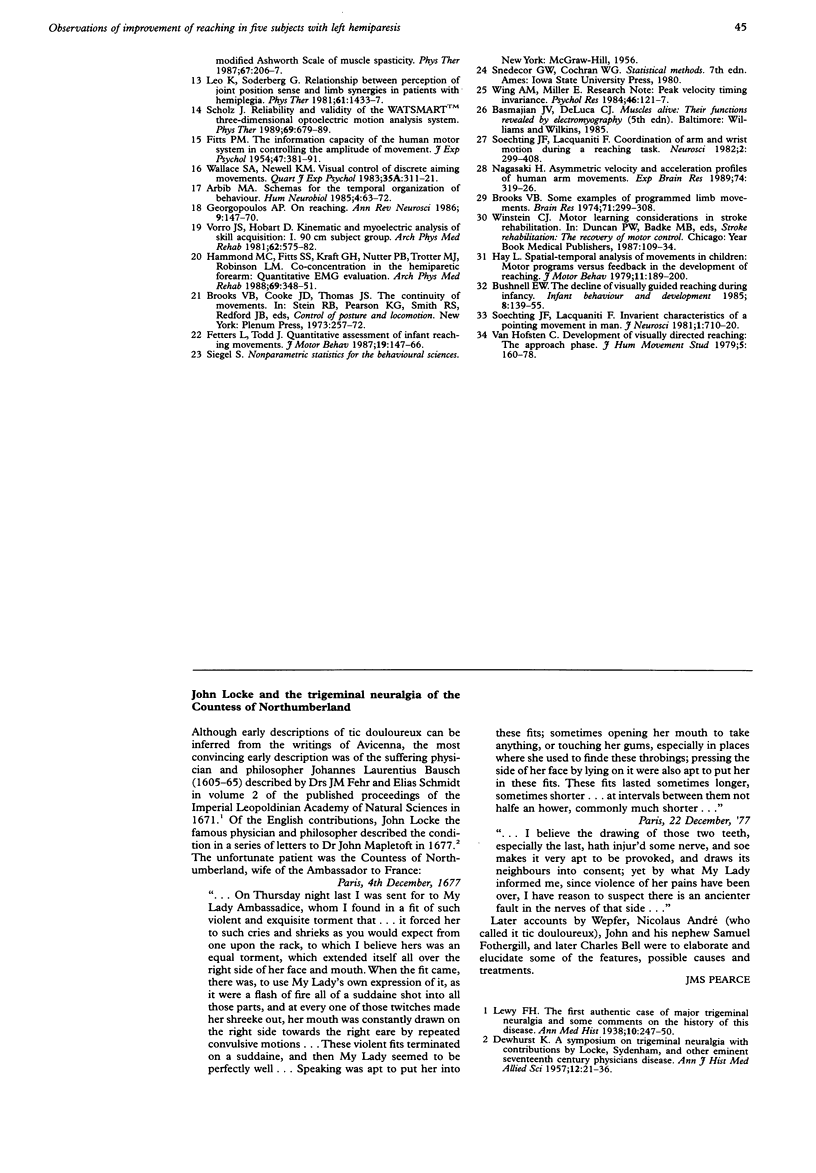
Selected References
These references are in PubMed. This may not be the complete list of references from this article.
- Arbib M. A. Schemas for the temporal organization of behaviour. Hum Neurobiol. 1985;4(2):63–72. [PubMed] [Google Scholar]
- Basmajian J. V., Gowland C. A. The many hidden faces of stroke: a call for action. Arch Phys Med Rehabil. 1987 May;68(5 Pt 1):319–319. [PubMed] [Google Scholar]
- Basmajian J. V. The 38th annual John Stanley Coulter lecture. The Winter of Our Discontent: breaking intolerable time locks for stroke survivors. Arch Phys Med Rehabil. 1989 Feb;70(2):92–94. [PubMed] [Google Scholar]
- Brooks V. B. Some examples of programmed limb movements. Brain Res. 1974 May 17;71(2-3):299–308. doi: 10.1016/0006-8993(74)90973-1. [DOI] [PubMed] [Google Scholar]
- Brooks V. B., Watts S. L. Adaptive programming of arm movements. J Mot Behav. 1988 Jun;20(2):117–132. doi: 10.1080/00222895.1988.10735437. [DOI] [PubMed] [Google Scholar]
- Dombovy M. L., Bach-y-Rita P. Clinical observations on recovery from stroke. Adv Neurol. 1988;47:265–276. [PubMed] [Google Scholar]
- FITTS P. M. The information capacity of the human motor system in controlling the amplitude of movement. J Exp Psychol. 1954 Jun;47(6):381–391. [PubMed] [Google Scholar]
- Fetters L., Todd J. Quantitative assessment of infant reaching movements. J Mot Behav. 1987 Jun;19(2):147–166. doi: 10.1080/00222895.1987.10735405. [DOI] [PubMed] [Google Scholar]
- Fugl-Meyer A. R., Jäskö L., Leyman I., Olsson S., Steglind S. The post-stroke hemiplegic patient. 1. a method for evaluation of physical performance. Scand J Rehabil Med. 1975;7(1):13–31. [PubMed] [Google Scholar]
- Georgopoulos A. P. On reaching. Annu Rev Neurosci. 1986;9:147–170. doi: 10.1146/annurev.ne.09.030186.001051. [DOI] [PubMed] [Google Scholar]
- Hammond M. C., Fitts S. S., Kraft G. H., Nutter P. B., Trotter M. J., Robinson L. M. Co-contraction in the hemiparetic forearm: quantitative EMG evaluation. Arch Phys Med Rehabil. 1988 May;69(5):348–351. [PubMed] [Google Scholar]
- Lacquaniti F., Soechting J. F. Coordination of arm and wrist motion during a reaching task. J Neurosci. 1982 Apr;2(4):399–408. doi: 10.1523/JNEUROSCI.02-04-00399.1982. [DOI] [PMC free article] [PubMed] [Google Scholar]
- Leo K. C., Soderberg G. L. Relationship between perception of joint position sense and limb synergies in patients with hemiplegia. Phys Ther. 1981 Oct;61(10):1433–1437. doi: 10.1093/ptj/61.10.1433. [DOI] [PubMed] [Google Scholar]
- Nagasaki H. Asymmetric velocity and acceleration profiles of human arm movements. Exp Brain Res. 1989;74(2):319–326. doi: 10.1007/BF00248865. [DOI] [PubMed] [Google Scholar]
- Parker V. M., Wade D. T., Langton Hewer R. Loss of arm function after stroke: measurement, frequency, and recovery. Int Rehabil Med. 1986;8(2):69–73. doi: 10.3109/03790798609166178. [DOI] [PubMed] [Google Scholar]
- Schenkenberg T., Bradford D. C., Ajax E. T. Line bisection and unilateral visual neglect in patients with neurologic impairment. Neurology. 1980 May;30(5):509–517. doi: 10.1212/wnl.30.5.509. [DOI] [PubMed] [Google Scholar]
- Scholz J. P. Reliability and validity of the WATSMART three-dimensional optoelectric motion analysis system. Phys Ther. 1989 Aug;69(8):679–689. doi: 10.1093/ptj/69.8.679. [DOI] [PubMed] [Google Scholar]
- Soechting J. F., Lacquaniti F. Invariant characteristics of a pointing movement in man. J Neurosci. 1981 Jul;1(7):710–720. doi: 10.1523/JNEUROSCI.01-07-00710.1981. [DOI] [PMC free article] [PubMed] [Google Scholar]
- TWITCHELL T. E. The restoration of motor function following hemiplegia in man. Brain. 1951 Dec;74(4):443–480. doi: 10.1093/brain/74.4.443. [DOI] [PubMed] [Google Scholar]
- Vorro J., Hobart D. Kinematic and myoelectric analysis of skill acquisition: I. 90cm subject group. Arch Phys Med Rehabil. 1981 Nov;62(11):575–582. [PubMed] [Google Scholar]
- Wallace S. A., Newell K. M. Visual control of discrete aiming movements. Q J Exp Psychol A. 1983 May;35(Pt 2):311–321. doi: 10.1080/14640748308402136. [DOI] [PubMed] [Google Scholar]
- Wing A. M., Lough S., Turton A., Fraser C., Jenner J. R. Recovery of elbow function in voluntary positioning of the hand following hemiplegia due to stroke. J Neurol Neurosurg Psychiatry. 1990 Feb;53(2):126–134. doi: 10.1136/jnnp.53.2.126. [DOI] [PMC free article] [PubMed] [Google Scholar]


